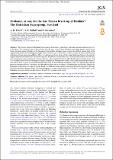Files in this item
Evidence, or not, for late Tonian break-up of Rodinia? The Dalradian Supergroup, Scotland
Item metadata
| dc.contributor.author | Prave, Tony | |
| dc.contributor.author | Fallick, A.E. | |
| dc.contributor.author | Kirsimäe, K. | |
| dc.date.accessioned | 2023-03-08T09:30:09Z | |
| dc.date.available | 2023-03-08T09:30:09Z | |
| dc.date.issued | 2023-03-03 | |
| dc.identifier | 282303529 | |
| dc.identifier | ba9bbaa9-82ac-4db7-ac0b-98d213e853d6 | |
| dc.identifier | 85149988656 | |
| dc.identifier.citation | Prave , T , Fallick , A E & Kirsimäe , K 2023 , ' Evidence, or not, for late Tonian break-up of Rodinia? The Dalradian Supergroup, Scotland ' , Journal of the Geological Society , vol. 180 , no. 2 , jgs2022-134 . https://doi.org/10.1144/jgs2022-134 | en |
| dc.identifier.issn | 0016-7649 | |
| dc.identifier.other | ORCID: /0000-0002-4614-3774/work/130659756 | |
| dc.identifier.uri | https://hdl.handle.net/10023/27123 | |
| dc.description | Funding: Fieldwork was funded by A.R.P. Analyses funded by University of Tartu. | en |
| dc.description.abstract | The Tonian-Cambrian Dalradian Supergroup, Scotland, is a siliciclastic-carbonate succession as much as 10 km thick. The consensus view is that its lower part, the mid-late Tonian Grampian and Appin groups, formed in rift basins: deep-marine turbidites of the former infilled rift depocentres and shallow-marine strata of the latter marked basin-bounding palaeohighs. That scenario is used as evidence to infer onset of break-up of Rodinia between Laurentia and Baltica. However, deformation during mid-Ordovician Caledonian orogenesis obscured original depositional frameworks. Reconstructing those frameworks (and hypothesised rift basins) relied on trace- and major-element geochemistry of carbonate rocks to assign units to either the Grampian or Appin groups, i.e. to rift depocentres or basin-bounding palaeohighs, respectively. We report new carbon and oxygen isotope and geochemical data to create a revised stratigraphic framework for the Grampian and Appin groups. Our findings show that previous geochemical-based correlations are unreliable and that there is no evidence for palaeohighs or rift basins. Instead, the Grampian-Appin groups are a deeper- to a shallower-marine (flysch to molasse) succession formed in response to the mid-Tonian Knoydartian Orogeny. From a Scottish perspective, evidence for break-up of Rodinia is recorded higher in the Dalradian succession during deposition of the early Cryogenian Argyll Group. | |
| dc.format.extent | 11 | |
| dc.format.extent | 4626101 | |
| dc.language.iso | eng | |
| dc.relation.ispartof | Journal of the Geological Society | en |
| dc.subject | QE Geology | en |
| dc.subject | T-NDAS | en |
| dc.subject | SDG 14 - Life Below Water | en |
| dc.subject | MCC | en |
| dc.subject.lcc | QE | en |
| dc.title | Evidence, or not, for late Tonian break-up of Rodinia? The Dalradian Supergroup, Scotland | en |
| dc.type | Journal article | en |
| dc.contributor.institution | University of St Andrews. School of Earth & Environmental Sciences | en |
| dc.contributor.institution | University of St Andrews. Marine Alliance for Science & Technology Scotland | en |
| dc.contributor.institution | University of St Andrews. Scottish Oceans Institute | en |
| dc.contributor.institution | University of St Andrews. St Andrews Sustainability Institute | en |
| dc.contributor.institution | University of St Andrews. St Andrews Isotope Geochemistry | en |
| dc.identifier.doi | https://doi.org/10.1144/jgs2022-134 | |
| dc.description.status | Peer reviewed | en |
| dc.identifier.url | https://doi.org/10.6084/m9.figshare.c.6317830 | en |
| dc.identifier.url | https://www.lyellcollection.org/doi/10.1144/jgs2022-134 | en |
This item appears in the following Collection(s)
Items in the St Andrews Research Repository are protected by copyright, with all rights reserved, unless otherwise indicated.

